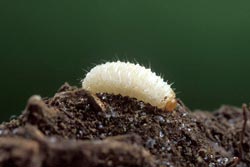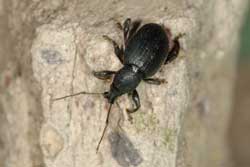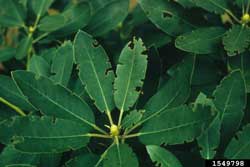Black Vine Weevil—Otiorhynchus sulcatus
Black vine weevils can be a serious pests in nurseries and home ornamentals. They feed on over 100 kinds of trees, vines and flowers, prefering yews and rhododendrons, but also attacking hemlocks, begonias, geraniums, lilacs, peonies, raspberries and strawberries. The adults feed on foliage, but the larvae do the real damage by chewing on the roots, sometimes girdling the main stem, and often killing the host plant.

Black vine weevil larvae are off-white with a brown head, C-shaped and legless. They grow slowly over the summer, molting 5 or 6 times and reaching a mature size of 5/8 inch.
Click on images to view full-size
Identification and Control Information
- Woody Ornamental IPM: Black Vine Weevil (PDF)—PennState Cooperative Extension
- Practical Black Vine Weevil Management (PDF)—American Rhododendron Society
- GreenShare Factsheets: Black Vine Weevil (PDF)—University of Rhode Island Landscape Horticulture Program
[Photos, left to right: Peggy Greb, USDA Agricultural Research Service, Bugwood.org; Joseph Berger, Bugwood.org; Jim Baker, North Carolina State University, Bugwood.org]

